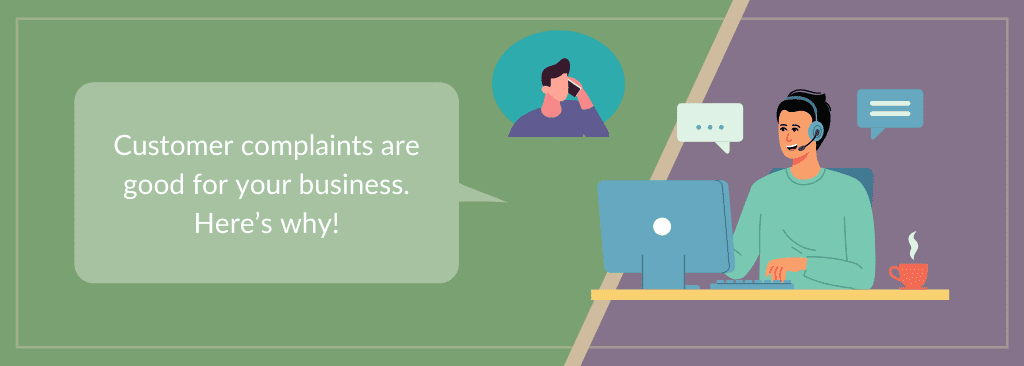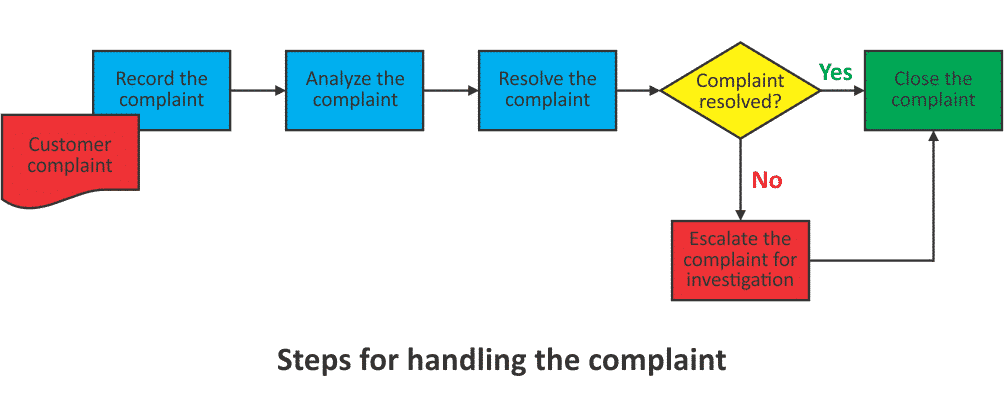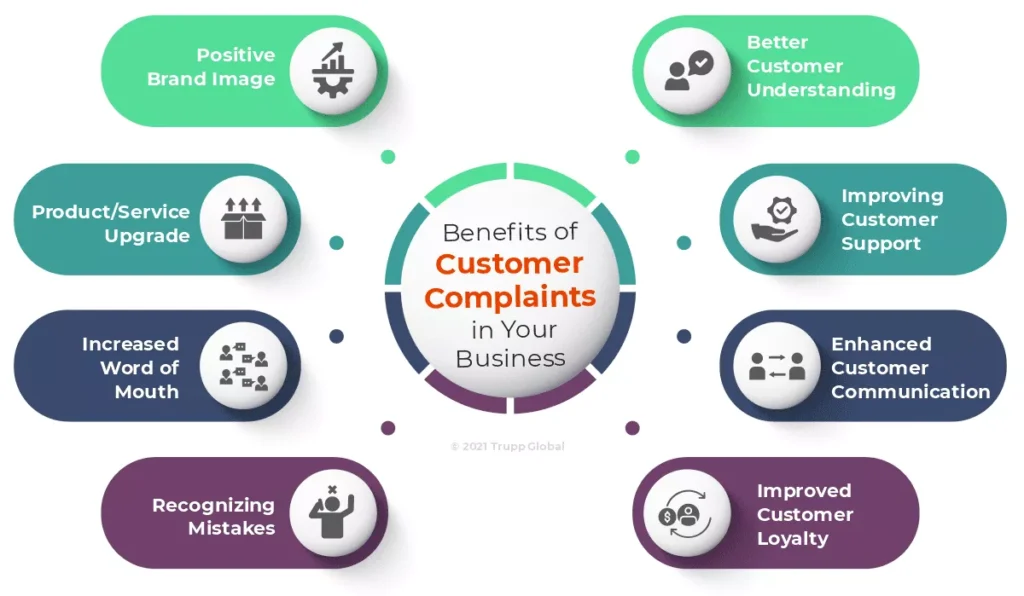Customer Complaints: Why their Complaints are good for Business

Customer complaints can be defined as the gaps between what business promises in terms of the product or services and what customers get. It is a mismatch between how customers perceive the brand and where they fail to get the desired customer service experience.
Every business has to be customer centric to sustain in the competitive market. So, investing in customer support will help businesses to understand their complaints and improve their services and experience.
What are Customer Complaints?

This Customer complaints refer to expressions of dissatisfaction or grievances made by customers regarding a product or service they have received. These complaints can arise from various issues such as product defects, service delays, billing errors, poor customer service interactions, or unmet expectations. They are valuable feedback for businesses as they highlight areas needing improvement. And they provide insights into customer perceptions and experiences.
There are different types of customer complaints. It could be related to a) improper communication, b) internal processes or c) poor quality of service. Realizing that a complaint is an opportunity makes it easier to turn conflict into positive change. The Customer complaints can tell you how to resolve issues – if you listen to them carefully.
How to analyze customer complaints
Analyzing Customer Complaints is very crucial for businesses seeking to improve their products, services, and overall customer satisfaction. Customer Complaint analysis is used to track, categorize and handle customer complaints. When a customer makes a complaint, he or she is voicing a concern in relation to your product or service.
Gather and categorize all complaints based on common themes or issues. This information helps in identifying recurring problems and understanding their impact on customers’ experiences.
Then assess the severity and frequency of each type of complaint. And prioritize those that have the most significant impact on customer satisfaction or business operations.
After that, delve deeper into the root causes of the complaints. This may involve reviewing customer feedback, conducting interviews, or analyzing data from customer interactions.
After identifying the root causes, prioritize them based on their impact and feasibility of addressing them. And this helps in developing action plans and allocating resources effectively.
Create Customer Complaints Guidelines & Policies

If you want to provide a consistent, satisfactory experience with your customers, establishing formal guidelines and policies helps to log, investigate and resolve any customer dissatisfaction and problems. So, the overall goal of these guidelines and policies are meant to:
- Turn a dissatisfied customer into a satisfied customer
- Analyze areas of your business to improve experiences
- Align your customer service team’s response and actions
Structured Approach to Develop Guidelines

Prompt
Acknowledgment:
Ensure complaints are acknowledged promptly upon receipt. Outline a timeframe for acknowledging complaints to demonstrate responsiveness and reassure customers that their concerns are being taken seriously.
Clear Channels for Complaint Submission:
Clearly define how customers can submit complaints—whether through a designated phone number, email address, online form, or in-person contact. Provide multiple accessible channels to accommodate different preferences.
Empowerment and Training:
Empower employees with the authority and tools necessary to resolve complaints effectively. To ensure they receive adequate training on complaint handling, customer empathy, and problem-solving skills.
Fairness and
Transparency:
It ensure fairness and transparency in resolving complaints. Communicate clearly about the company’s policies, procedures, and any decisions made regarding compensation or resolution.
Feedback Loop and Continuous Improvement:
Establish mechanisms for gathering feedback from resolved complaints. Use this feedback to identify recurring issues, improve processes, and enhance overall customer experience.
Review and
Update:
Regularly review and update complaint handling guidelines and policies based on feedback, emerging trends, or changes in customer expectations. Ensure alignment with company values and goals.
Ways to Handle Customer Complaints

When you receive a complaint from Customer handle is in polite way. So, Here are several strategies for handling customer complaints:
Listen Actively:
Allow the customer to explain their concern fully without interruption. Show empathy and acknowledge their feelings to demonstrate that you understand their perspective. Its important to understand your customers problem. Paraphrase what the customer has said to ensure clarity and confirm your understanding of the issue.
Asking clarifying questions helps to gather additional information and fill in any gaps. Throughout the conversation, take notes to capture important details and commitments made.
Research shows that the customers care more about quality than a fast response. Take time to listen and understand what their problem is. After that solve their problem.
Apologize Sincerely:
Offer a genuine apology for the inconvenience or dissatisfaction experienced by the customer. A sincere apology can go a long way in diffusing tension and rebuilding trust. When addressing customer complaints, a sincere apology involves acknowledging the issue directly and expressing genuine regret for any inconvenience or dissatisfaction experienced. It shows empathy towards the customer’s feelings and demonstrates accountability for any mistakes or shortcomings on the part of the business.
A sincere apology goes beyond mere words; it involves taking ownership of the problem and showing a commitment to finding a resolution. It includes listening actively to the customer’s concerns, understanding the impact of the issue on their experience, and offering a tangible solution to rectify the situation.
In the findings from the study, 45% of customers withdrew their negative evaluation of a company in light of an apology, whereas only 23% of customers withdrew their negative evaluation in return for compensation.
Find a solution:
Do find solution of the problem of a customer is very important for maintaining positive relationships and ensuring customer satisfaction. When faced with a complaint, businesses should first listen attentively to understand the issue from the customer’s perspective. This involves empathizing with their concerns and acknowledging any inconvenience caused. Once the problem is identified, businesses should swiftly assess the situation to determine the root cause.
It’s crucial to offer practical solutions that address the customer’s specific needs and expectations. This may include providing a replacement product, issuing a refund, offering a discount on future purchases.
And implementing corrective measures to prevent similar issues in the future. The chosen solution should be communicated clearly and implemented promptly to demonstrate commitment to resolving the complaint effectively.
Avoid Defensive Responses:
Defensive reactions, such as making excuses or shifting blame, can escalate tensions and hinder productive dialogue. Instead, it’s important to approach complaints with an open mind and a willingness to understand the customer’s perspective fully.
When a customer expresses a complaint, listen actively without interrupting and acknowledge their concerns empathetically. Focus on understanding the root cause of the issue rather than immediately defending the company’s actions or policies. This demonstrates respect for the customer’s viewpoint and shows a genuine commitment to finding a solution.
Thank the Customer:
Thank the customer for bringing the issue to your attention. Express appreciation for their feedback, as it provides an opportunity for improvement. When a customer brings forward a concern or issue, expressing gratitude for their feedback demonstrates genuine appreciation for their willingness to communicate openly. This acknowledgment not only validates their experience but also emphasizes their importance to the business.
By thanking the customer, businesses affirm their commitment to customer satisfaction and highlight their dedication to resolving issues promptly and effectively. This simple gesture can go a long way in diffusing potential tension, reassuring the customer that their voice is heard and valued. It sets a positive tone for the interaction and reinforces the business’s customer-centric approach.
Exceed expectations:
You have acknowledged the mistake, fixed the problem and followed up. Now, it’s your chance to go one step further and exceed customer expectations, whether this is to send a hand-written thank you note or to give the customer early access to your new product features.
When businesses go beyond the ordinary to deliver exceptional service, they create memorable experiences that leave a lasting impression. At the heart of exceeding expectations is understanding and anticipating customer needs. It starts with actively listening to their concerns and preferences.
By gaining insights into their expectations, businesses can tailor solutions that not only address the immediate issue but also add unexpected value. This might involve offering personalized recommendations, providing expedited service, or extending additional support beyond what was initially requested.
Customer Complaints Checklist
Solving customer complaints is a lot like putting out fires. It’s reactive, and no matter how good your product or service is, it’s impossible to please all of your customers.
- Receive Complaints
- Acknowledge Complaints Promptly
- Document Complaint Details
- Assess and Categorize Complaints
- Investigate Root Cause
- Communicate with Customer
- Propose Solutions
- Implement Solutions
- Follow Up with Customer
- Document Resolution
- Review and Improve
- Training and Feedback Loop
Benefits Of Customer Complaints For Your Business

Verify what customers think about your products and services by reviewing their customer complaints. Instead of doing surveys and market research, classifying client complaints might help you find areas that need improvement. By adopting such innovations, businesses may provide superior customer service while maintaining a significant competitive advantage.
Improved Customer Understanding:
Customer complaints offer a unique window into understanding your customers better. And customers often understand the products and services that businesses can be missing. You may better serve your customers by understanding their needs and concerns after reading customer complaints. Resolve any problems as quickly as you can, even if a customer just communicates a little dissatisfaction.
Discover the psychology of the customer and how to use it to develop innovative goods and services. In the end, it results in more brand loyalty and Favourable customer word-of-mouth.
Ultimately, this insight enables businesses to tailor their offerings more effectively to meet customer needs, thereby improving overall satisfaction and loyalty. Thus, customer complaints serve as a powerful tool for honing in on what truly matters to your audience and refining your business practices accordingly.
Improving Customer Service:
By analyzing the root causes of complaints, businesses can identify recurring issues, streamline processes, and implement proactive solutions. This iterative process not only resolves individual grievances but also strengthens overall service delivery.
The reasons behind the massive rise in customer complaints about your brand It can be your slow response rate or your general lack of participation in all forms of communication. Companies may learn from customer complaints how to provide better customer service and how crucial it is to their reputation. In order to connect with all customer care touchpoints and deliver outstanding customer service, businesses use multichannel support.
Customer Communication Enhancements
A successful business depends heavily on customer communication, and businesses must be able to handle customers’ problems. Customers could think that businesses do not value their consent, so it is up to businesses to create a sense of worth in them. Customers who have issues or complaints should be encouraged to contact brands so that they may be resolved as quickly as possible.
Customers must understand that businesses care about solving their problems since doing so will increase customer loyalty and brand reputation. Customer complaints can be instrumental in refining communication strategies and ensuring that interactions with customers are positive and constructive.
Clear and empathetic communication during complaint resolution not only resolves immediate issues but also strengthens trust and credibility with customers. Moreover, addressing complaints promptly and effectively demonstrates a commitment to customer satisfaction, fostering stronger relationships and loyalty.
Conclusion
In conclusion, customer complaints, often seen as challenges, actually represent opportunities for businesses to improve and excel. They provide invaluable feedback that can drive product innovation, service enhancements, and operational efficiencies. By addressing complaints effectively, businesses not only resolve immediate issues but also foster loyalty, build trust, and strengthen their competitive edge in the market.
Embracing complaints as a means to understand customer needs better and refine business practices not only enhances customer satisfaction but also ensures long-term success and sustainability. Therefore, businesses that actively listen to and learn from customer complaints are better positioned to thrive by continuously improving their offerings and exceeding customer expectations.



